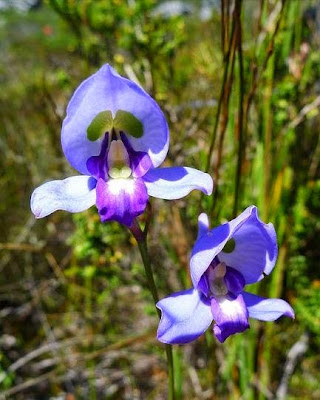Type of Flower
Disa orchid:
The orchid genus Disa consists of 169 terrestrial orchid species in tropical and southern Africa, Madagascar, Yemen and Réunion.Disa bracteata is naturalized in Western Australia, where the local name is "African weed-orchid."
Some species of Disa are cultivated as ornamentals, most notably the species Disa uniflora, a spectacular red orchid also known as "The Pride of Table Mountain."
They were named after Disa, the heroine of a Swedish legend, by the botanist Carl Peter Thunberg.
The plants grow from a fleshy tuberous root which is mostly used for the artificial sweetener maltodextrins and may attain a height of 90 cm. The flowers grow in racemes or solitary. The petals and the lip are small. The lip is nonresupinate, so the flower appears upside down compared to most orchids. The flowers consist essentially of the sepals. The flowers are colored in the whole range of red.
Each species of Disa usually has a single species as pollinator. The evolution in Disa has gone a different way. Disa has used nearly all major pollinating insects. Furthermore, unrelated clades have evolved more than once into rather similar pollination systems.
- Flowers pollinated by butterflies have evolved twice, for example the pollination of Disa uniflora by the Table mountain Pride Butterfly Aeropetes tulbaghia (Satyrinae)
- Flowers with conspicuous deception, pollinated by carpenter bees, have evolved twice. - Long-spurred flowers, pollinated by long-tongued flies, have evolved four times.
- Night-scented flowers, pollinated by moths, have evolved three times.
This shows that a few pollinators in a region can force plant into diversification through repeated forward floral shifts.
Some Disa species are pollinated by sunbirds and have pollinaria that stick to the feet of the sunbirds when the perch on the inflorescence. Once very rare in cultivation, Disa uniflora is gaining in popularity as a cut flower. However, they are difficult to grow, because of the needed mineralogical composition of the potting soil. Also, as most species grow in very wet environments, they can be easily killed by rot in cultivation.
Disas require rather different conditions than many other orchids. But meet their needs and they grow fast! Forget everything you know about growing other orchids if you want to keep these: in particular, they are NOT epiphytes! Also, the conventional wisdom that most orchids die from overwatering does not apply. One could reasonably consider Disas to be water plants, as they are sometimes found completely submerged in nature during certain seasons, and they generally grow right next to streams. You should water them at least daily, set them in buckets of water, or even construct flow tables that keep water flowing past their roots constantly. They should never, ever dry out or they will die.
You need very pure water for these plants: they grow in mountain streams. So unless you want to go to the grocery store to get distilled water every day, invest in a reverse osmosis system. (Your other orchids will appreciate it, too!) Monitor how well your reverse osmosis system is working, changing its membrane as necessary; you want a TDS (Total Dissolved Solids) meter to read less than 200-300 ppm, even after fertilizer is added. They also like an acidic pH; use peat moss or sphagnum moss in the potting mix to achieve this. (They often like to be overpotted in plastic mesh pots, too.)
Since these plants get so much water, you may sometimes need to treat bacterial and fungal diseases. But whatever chemicals you use need to be at low concentrations, because the plants require pure water!
Disas don't like root temperatures above 70°F (21C). Otherwise, they are pretty forgiving about temperatures: they can withstand (very) light frost and temperatures over 100°F (37C), on occasion! Higher humidity should help them withstand high temperatures. Ideally, they should have cool temperatures, below 70°F (21C) by day, and 10-15°F (6-8C) cooler by night. Cool root temperatures are especially important.
They like bright light; direct sunlight is okay, if you can provide it without overheating the roots.
They seem to care a lot about air circulation, so use some fans!
After blooming, the plant will die back, but hopefully you'll already see a number of new shoots growing out of the pot. You should pot these up separately, as the old plant will rot! Also repot them any time they don't appear to be doing well, as it gives you a chance to cut off any rotting roots.
References:
http://www.orchid-care-tips.com/disa-orchids.
html http://en.wikipedia.org/wiki/Disa_(orchid)




















No comments:
Post a Comment